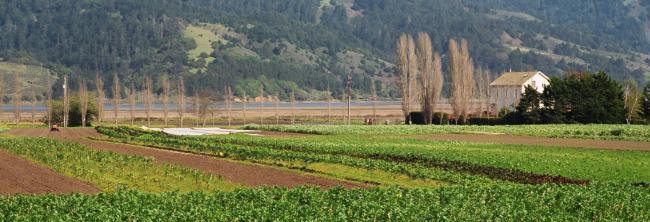Getting Started in Farming & Ranching in Marin

To be sure your farming or ranching dream can come to fruition and be sustainable, it is important to understand your land and location, natural resources, market, business plan, and more. Planning with the following topics in mind is fundamental for successful farms and ranches. Check out the companion printable factsheet and consult with the Marin County Agricultural Ombudsman to dig deeper into any of the topics below.
Land and Location: Where will you farm?
When buying land is not feasible, consider options for leasing land. Regardless of whether you own or rent, though, be sure you know everything you can about the land, especially the aspects listed below, before any commitments are made. If you are new to farming, you might start out by leasing from an experienced farmer or rancher that is well acquainted with the needs of an agricultural producer and attuned to the cycles of the business and production. It is also important to consider the zoning and permitting policies and regulations that apply to the property, making sure that they allow the activities you plan to conduct.
Resources:
- Getting started with Farm Leases Factsheet and Land Leasing Toolkit from Land For Good
- Land opportunities through California FarmLink
- Ask the Marin County Agricultural Ombudsman about zoning and land use on your property
- Marin County Planning and Agriculture Factsheet
- Community Development Agency Marin County
- Land Leases and Rents (UC Small Farm Program)
- National Young Farmers Coalition's "Finding Farmland" Course
- Run the basic numbers on purchasing farmland using the Finding Farmland Calculator from the National Young Farmers Coalition
Natural Resources
Soil: Online soil survey maps at NRCS or California Soil Resource Lab can help you get an idea of what soil types are prevalent in your area and then a laboratory test can confirm exactly the texture and status of soil in your respective fields and pastures. These results will help you plan your land use, crop selections, and soil management.
Resources:
- NRCS Web Soil Survey
- California Soil Resource Lab
- Selected Plant and Soil Labs in Northern and Central California - UCCE Sonoma County
Topography: Understanding the topography of your land will also impact what you can produce. The land or portions of it may be flat, hilly, or too steep for some uses. This knowledge is also helpful for erosion and run-off control, especially in the rainy season.
Climate and water: Consider if the climate is appropriate for what you plan to produce. Some considerations include the risk of frost, prevailing winds, average high and low temperatures throughout the seasons, and water availability. Will the short period of winter rainfall provide sufficient water to make it through the warm, dry summer? What are the yearly and seasonal livestock and crop water demands? It is important to understand local water availability and limitations.
Resources:
- California Irrigation Management Information System
- Rainfall Capture and Storage for Marin Agriculture Factsheet
Conservation: Another consideration is the potential for conservation that can complement the agricultural practices on your land. Consider the biodiversity, wildlife, ecosystem services, watershed, renewable energy potential and other natural resources that can be protected and improved on your land. Oftentimes, attending to needs of the greater ecosystem provides a net benefit to the productivity and efficiency of your ag operation. There are local, state and federal entities that not only provide technical assistance in planning a conservation project but can connect you to grants and other cost-share programs to help pay for the work.
- Marin Resource Conservation District
- Natural Resources Conservation Service Funding Programs
- CA Dept of Food and Agriculture Environmental Farming & Innovation Incentive Programs
Business Marketing and Financing
Business plan and Financing: Your business plan depends on many factors including, but not limited to, your goals, resources, capital, risk adversity, and potential markets. A business plan will include all the necessary inputs and hoped-for outputs in a well thought-out timeline.? Determine the costs of production, cash flow, and potential profitability of your agricultural business. Additionally, you should plan how you will manage your financial risk, strategies for monitoring and curtailing costs, and a method for evaluating your business and marketing progress.?Preparing budgets is an important part of your business plan and securing financing. Your plan will demonstrate to potential lenders, investors, and business partners that you have fully researched your idea and know how to produce and sell it. Also be sure to acquire the appropriate insurance before getting underway. That may include liability insurance for your products, a ranch liability policy to cover accidents on the property and commercial vehicle policies to cover delivery vehicles, etc.
- Farm Enterprise Management Page
- UC Farm Business & Marketing Site for Fresh Produce Growers
- UC Small Farm Handbook, 2nd Edition
- Farm Business Planning Reading List - New England Small Farm Institute
- USDA Farm Business Planning Resources
- USDA New Farmers Toolkit – Make a Farm Business Plan
- Cultivating Commerce
Marketing: Marketing should begin before sowing seeds or purchasing livestock. There are a variety of marketing models used by many farmers today. These include farmers’ markets, Community Supported Agriculture (CSA), farm stands, pick-your-own, agritourism, contracts with retailers, restaurants, processers, institutions, and more. Each plays to a different strength, depending on the farmer, the products and the communities you are close to. It is important to understand how to enter these markets and grow a customer base, while enjoying friendly relationships with fellow farmers.
Resources:
- Market Research and Market Strategy Reading Lists – New England Small Farm Institute
- Marketing & Specialty Foods Information – UC Small Farm Program
- USDA New Farmers Toolkit – Build Your Market
- Getting Started Selling at Farmers Markets Factsheet
Farm and Ranch Planning
Production Planning: Creating a plan allows you to be prepared for the inputs you will need at the beginning of every season. You will plan out your cropping or grazing patterns and rotations based on local seasonality and your market. It is also important to consider nutrient management for optimum production such as nutrient cycling, application of fertilizer, compost, or cover crops. For many perennial crops or animal production operations it is helpful to plan years into the future. County Crop reports can provide an idea of what is currently produced in your county, what is right for your climate, and where you can find your niche.
Resources:
- UCCE Marin Resources for Farmers Page
- UC Small Farm Program Specialty Crops Information
- UC Ag & Natural Resources Catalog of Publications (including production manuals such as Organic Vegetable Production and Fundamentals of Beef Management)
- UC Davis Cost & Profitability Studies
- Farm Enterprise Selection (UC Small Farm Program)
Pest Management: In order to bring the best product to market, you will need a plan for pest management. At the University of California Integrated Pest Management website look up more information and guidelines by pest or crop.
Organic certification: If you are considering organic management and certification, be sure to understand what’s required.
- UCCE Marin Organic Certification Page
- Getting Started with Organic Certification Factsheet
- NCAT-ATTRA Organic Farming Resources
Post-harvest handling and processing: You have to plan how your product will be slaughtered, packaged, stored, and transported, and the infrastructure (cooler, truck, etc.) required. A food safety plan is another key element.? There may be many complicated regulations you are subject to, especially for processing operations. If you are interested in value-added products, some processing may be required. Depending on the kind of processing required, you should research what zoning, permits, and licensing may be necessary. You might be able to rent space in a commercial kitchen to process your goods. Find out more from local, state, and federal food agencies.
Resources:
- UCCE Marin Food Safety Page
- Small Farm Program Food Safety information
- Livestock Slaughter and Processing Factsheet
- Food Processing Factsheet
- UC Cottage Foods Page
- Cottage Food Operations Page – Marin County Department of Environmental Health
- Cottage Food Law FAQ – The Sustainable Economies Law Center
Labor: At a certain size and volume of production, or season, you may need to hire employees. You will have to comply with labor codes, health and safety laws, and consider the necessary insurance. Think about what kind of work force you anticipate, how you will manage and train employees, and what kinds of benefits you will be able to provide.
Resources:
- UCCE Marin Farm Labor Requirements Page
- UCCE Marin Workshop – Being Prepared for Labor and Health & Safety Inspections
Training, Classes and More: a wide variety of programs, classes, centers and resources are available nearby.
- Indian Valley Organic Farm at College of Marin
- Shone Farm at Santa Rosa Junior College
- Green String Institute
- Occidental Arts and Ecology Center
- Agriculture and Land Based Training Association
- UC Santa Cruz Center for Agroecology and Sustainable Food Systems
- UC Davis Student Farm
- Farm Academy at Center for Land Based Learning
- The School of Adaptive Agriculture (formerly Grange Farm School)



